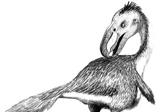The Muhammad Ali of predators
An ancient "terror bird" used an agile attack-and-retreat fighting strategy reminiscent of the bobbing and weaving of boxer Muhammad Ali, scientists have found.
An ancient "terror bird" used an agile attack-and-retreat fighting strategy reminiscent of the bobbing and weaving of boxer Muhammad Ali, scientists have found.

Scientists have used sophisticated computer modeling to reveal that an ancient "terror bird" used an agile attack-and-retreat fighting strategy of which Muhammad Ali would approve.
Andalgalornis could not fly but it stood 1.4 metres tall, weighed 40 kilograms and had an unusually large, rigid skull and hawk-like hooked beak: it would have avoided close combat and used hatchet-like jabs to take down its prey, according to a new study by an international team published in the journal PLoS ONE.
Working with a complete fossil skull of the creature, which lived about six million years ago in north-western Argentina, the team using CT scanning and advanced engineering methods to examine its form, function and predatory behaviour.
"We found that this terror bird was well-adapted to drive in its deep, narrow beak then pull back with that wickedly recurved tip," says co-author Dr Stephen Wroe, Director of the Computational Biomechanics Research Group in the UNSW School of Biological, Earth and Environmental Sciences.
"As a heavyweight, its fighting style was more like that of a bobbing, weaving Muhammad Ali than a Joe Frazier wading into the fray and slugging it out."
The researchers applied engineering approaches called Finite Element Analysis to test the performance of the skull under different simulated feeding behaviours.
To read the full story go to the Faculty of Science newsroom.
Media contact: Dr Stephen Wroe | 02 9385 3866 | s.wroe@unsw.edu.au